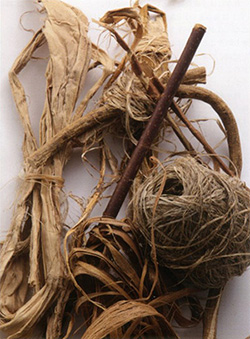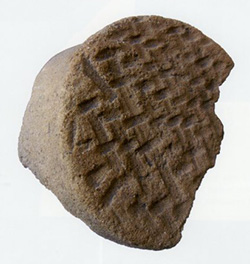- 木綿以前の布 -
日本には「衣食住」という言葉がある。 「衣」は着るもの、「食」は食べ物、「住」は住まい。 この三点が人間が生きるにあたっての基本的に必要な要素ということで、日本で はよく使われる言葉だ。
では、日本人の、古代から現代までの「衣食住」は、どのようなもので、どのよ うに変化していったのであろうか?
我々が、学校などで学んできた歴史上の人々、つまり、権力を持って歴史を動か してきた人々の「衣食住」は、文献や遺留品が博物館や美術館に多く収められており、容易に知ることが出来る。
しかしながら、そのような人々はいつの時代も全体の人口から見ればごく少数で ある。
ピラミッドの如くその配下には、多くの人々が, 歴史に翻弄されながらも、彼らなりの知恵と工夫で、生活していた。
その彼ら すなわち庶民の暮らしぶりや精神生活などの実態は、日本ではあまり 知られてこなかった。
特に「衣食住」の最初に並べられている「衣」に関しては 先に述べた貴族や大名、武士等の権力者や上流階級の衣装や、能や狂言衣装などは多数残され研究がなされている。
それらは、かれらの権力の象徴として、各時代の技術の粋を尽くして作られ、 すばらしい芸術品として、大切に保存されてきた。
その結果、それらの繊織品のみが、「日本の染織品」として、外国人はもとより日本人自身も認 識され続けてきたというのが現状だ。
ではいったい、歴史の表層には上らず、文献等で残されることも稀で、限られ た資料しか残されていない庶民の「衣」とはどんなものであってのであろうか?
この問題は、歴史学、民俗学 染織史のどの分野からも、特に扱われることが少 なく、手付かずに抜け落ちてきた感がある。
木綿以前
昔の庶民は「木綿の仕事着」、というのが現代人が抱くイメージであるが、木綿が日 本中の庶民の着るものになったのは、そんなに古いことではない。
木綿は、8世紀にインド人が日本に種子をもたらしたのが最初といわれている。 その後、栽培も行われること無く長い空白があり、13,4世紀になって中国からわずかに輸入されていたが、高級品として、庶民が手に入れられるものではなかった。
日本で急速に栽培され、布として庶民に広がったのは、江戸中期(18世紀半ば頃)と言われている。
それでは、木綿が容易に手に入れられるようになる以前の庶民は、どのような材料で、布を織っていたのか? それは、山や野に自生する木や草から糸を取り出していたのである。
代表的なものとしては、楮 科 オヒョウ 藤 葛、芭蕉、大麻 苧麻 イラクサ アカソなどである。
木や草からどのようにして糸になるのか
木の場合は、表皮と木材の間にある繊維質の層を剥いで取り出し、灰で長時間たき、発酵させ繊維だけをとり出す。
草の場合は、刈り取った後に煮出して表皮を腐らせたり(大麻)、あるいは刃物のようなもので削ぎ落としたりしながら(苧麻)中の繊維を取り出す。
取り出した繊維を一本づつ細く裂いて、更に長い糸にするために、一本一本、結んだり、絡めたりしながら、繋げていく。 その作業を「績む」と言う。 それらの繊維を総称して、靭皮繊維という。
靭皮繊維
木綿は、綿花を紡いでいくと自然に糸になり、絹は、蚕が出した糸をそのまま取り出したものだが、靭皮繊維は、自然の樹木や草から、人間が気の遠くなる時間と労力を費やしてはじめて糸になるのである。
日本では、驚くべき事に、縄文時代(BC145世紀からBC10世紀)後期ごろから、およそ昭和初期頃まで木綿が普及していても、一部の地方の山村や漁村等では、仕事着や日常着を このような草木の繊維で作っていた。
縄文時代の遺跡からは、木や草から繊維を取り出して、縒ったり、編んだりした 縄や布の実物の一部や、布の圧痕のある土器などが出土されている。
「縄文」の「縄」は縄の意味で、縄文土器の表面は、何らかの繊維を縒って縄状 にして、模様をほどこしてある。 縄文後期になると、機織り機もあらわれ、木や草から繊維を取り出して、糸に し、布にする技術はすでにあったと考えられる。
その頃の草や木の素材は大麻、アカソ、苧麻 オヒョウなどであろうと言われて いる。
縄文時代後期から昭和初期頃まで約3000年もの間、上記の素材以外にも、いろ いろ試された草や木もあったであろうが、糸の取り易さ、扱い易さ、布になった 時の心地よさなど諸々の事情で、淘汰されていき、先に述べた草や木が残ったのではな いかと推測される。

Category


布の圧痕のある縄文土器
Earthen vessel imprinted with cloth from the Jyomon period
- Before cotton -
Food. Clothing. Shelter. The three basic elements of human life. These three words hold special meaning in Japan where life was long a struggle for survival. How has the meaning of food, clothing and shelter changed from ancient times to the present day?
In school, we learned what people of privilege and influence ate, what they wore and how they were sheltered for there are plenty of documents and artifacts about the privileged classes left behind in museums. The wealthy were, however, only a small percentage of the whole population. Whereas the majority?the common people who lived their lives by using their own wits and ideas?are rarely presented. Not much is known about how they lived from day to day in Japan or about their spiritual life, and so forth.
Through clothing, however, a lot can be learned about Japanese art and culture. Clothes worn by men of importance like aristocrats, feudal lords, warriors and the gentry are well researched, and much has been learned from costumes worn by Noh actors depicting members of the upper classes. Garments painstakingly made with advanced techniques represented the wearer’s high status. They are carefully preserved as great works of art. Consequently, those elegant fabrics became synonymous with Japanese textiles.
What on earth, then, were the common people’s clothes like? Rarely featured in folklore or in the history of dyeing and textiles, their clothing was never fully brought to the foreground. It seems as if they have been left unexamined and even omitted from history.
Before Cotton
We have a tendency to think that long ago the common people wore clothes made of cotton, but it wasn’t that long ago that cotton first became available in Japan.
Cotton seeds are said to have been brought to Japan from India for the first time in the 8th Century. Afterward, there was a long stretch of time that cotton was not harvested for the making of cloth. In the 13th- and the 14th-centuries, a small amount of cotton was imported from China, but the common people couldn’t afford such a rare and expensive commodity. It is believed that it was in the mid- Edo period (c. mid-18th Century), that cotton began to be harvested and from that time forward became available to the common people in the form of cloth.
So, what kind of fibers did the common people weave cloth before they could afford cotton easily? The answer lies in the wild trees and plants that grew in the mountains and in the fields: paper mulberry, linden, elm, wisteria, kudzu, banana fiber, hemp, ramie, and nettle.
How is thread made from trees and grasses?
For trees, the layer between the bark and the wood is peeled and removed, then boiled with ash for a long time, and fermented. Only then can the fiber be taken out.
For grasses, after cutting, they are boiled until the outer layer dissolves (hemp) or they are shaved with a blade (ramie) to remove the fiber. The resulting fiber is torn into pieces and tied or braided together piece by piece to create a longer thread. This process is called ply-joining and these fibers are called bast fibers.
Cotton is turned into thread by spinning cotton wool. Silk is naturally produced by silkworms. Bast fiber threads that are made from natural trees and grasses are labor intensive and take an incredibly long time to make.
What is amazing about some local mountain and fishing villages in Japan is that they made their own work and casual clothes from these plant fibers from the last half of the Jomon period (14,500 BC ? 1,000 BC) to around the beginning of the Showa period (1926 - 1989), when cotton was commonly available.
Artifacts from the Jomon period included actual parts of twisted or braided ropes, cloth and various items. “Jo” from the word Jomon means rope. While some earthen vessels found by archeologists had cloth marks imprinted on them, many vessels had a specific rope pattern imprinted on them. In the last half of the Jomon period, the loom appeared. This suggests that they already had the technique to make cloth with threads created from the fibers of trees and grasses. It is said that in those days, they used plant materials such as hemp, nettle, ramie, and elm, to name a few.
For a period of about 3000 years, between the last half of the Jomon period and the beginning of the Showa period, people may have tried other plant materials than the ones mentioned above. However, it is believed that those materials proved difficult to make into thread or were not pliable or comfortable enough on the skin to be used as clothing. Eventually, the previously mentioned grasses and trees proved workable and remained in use.
Food. Clothing. Shelter. The three basic elements of human life. These three words hold special meaning in Japan where life was long a struggle for survival. How has the meaning of food, clothing and shelter changed from ancient times to the present day?
In school, we learned what people of privilege and influence ate, what they wore and how they were sheltered for there are plenty of documents and artifacts about the privileged classes left behind in museums. The wealthy were, however, only a small percentage of the whole population. Whereas the majority?the common people who lived their lives by using their own wits and ideas?are rarely presented. Not much is known about how they lived from day to day in Japan or about their spiritual life, and so forth.
Through clothing, however, a lot can be learned about Japanese art and culture. Clothes worn by men of importance like aristocrats, feudal lords, warriors and the gentry are well researched, and much has been learned from costumes worn by Noh actors depicting members of the upper classes. Garments painstakingly made with advanced techniques represented the wearer’s high status. They are carefully preserved as great works of art. Consequently, those elegant fabrics became synonymous with Japanese textiles.
What on earth, then, were the common people’s clothes like? Rarely featured in folklore or in the history of dyeing and textiles, their clothing was never fully brought to the foreground. It seems as if they have been left unexamined and even omitted from history.
Before Cotton
We have a tendency to think that long ago the common people wore clothes made of cotton, but it wasn’t that long ago that cotton first became available in Japan.
Cotton seeds are said to have been brought to Japan from India for the first time in the 8th Century. Afterward, there was a long stretch of time that cotton was not harvested for the making of cloth. In the 13th- and the 14th-centuries, a small amount of cotton was imported from China, but the common people couldn’t afford such a rare and expensive commodity. It is believed that it was in the mid- Edo period (c. mid-18th Century), that cotton began to be harvested and from that time forward became available to the common people in the form of cloth.
So, what kind of fibers did the common people weave cloth before they could afford cotton easily? The answer lies in the wild trees and plants that grew in the mountains and in the fields: paper mulberry, linden, elm, wisteria, kudzu, banana fiber, hemp, ramie, and nettle.
How is thread made from trees and grasses?
For trees, the layer between the bark and the wood is peeled and removed, then boiled with ash for a long time, and fermented. Only then can the fiber be taken out.
For grasses, after cutting, they are boiled until the outer layer dissolves (hemp) or they are shaved with a blade (ramie) to remove the fiber. The resulting fiber is torn into pieces and tied or braided together piece by piece to create a longer thread. This process is called ply-joining and these fibers are called bast fibers.
Cotton is turned into thread by spinning cotton wool. Silk is naturally produced by silkworms. Bast fiber threads that are made from natural trees and grasses are labor intensive and take an incredibly long time to make.
What is amazing about some local mountain and fishing villages in Japan is that they made their own work and casual clothes from these plant fibers from the last half of the Jomon period (14,500 BC ? 1,000 BC) to around the beginning of the Showa period (1926 - 1989), when cotton was commonly available.
Artifacts from the Jomon period included actual parts of twisted or braided ropes, cloth and various items. “Jo” from the word Jomon means rope. While some earthen vessels found by archeologists had cloth marks imprinted on them, many vessels had a specific rope pattern imprinted on them. In the last half of the Jomon period, the loom appeared. This suggests that they already had the technique to make cloth with threads created from the fibers of trees and grasses. It is said that in those days, they used plant materials such as hemp, nettle, ramie, and elm, to name a few.
For a period of about 3000 years, between the last half of the Jomon period and the beginning of the Showa period, people may have tried other plant materials than the ones mentioned above. However, it is believed that those materials proved difficult to make into thread or were not pliable or comfortable enough on the skin to be used as clothing. Eventually, the previously mentioned grasses and trees proved workable and remained in use.
Copyright 2002 Gallery Kei. All rights reserved.